The Camino de Santiago is perhaps one of the most famous walking routes in Europe, but it is also one of the longest. At least, if you plan to walk one of the full routes. But did you know that you can also walk just the last 100 km to Santiago de Compostela? This pilgrimage route along the Camino Frances takes you in 5 days from Sarria to Santiago de Compostela, through Galicia in northern Spain. In this article, I’ll tell you everything you need to know about this Camino de Santiago route, including a day-to-day description and how to best organize your Camino.
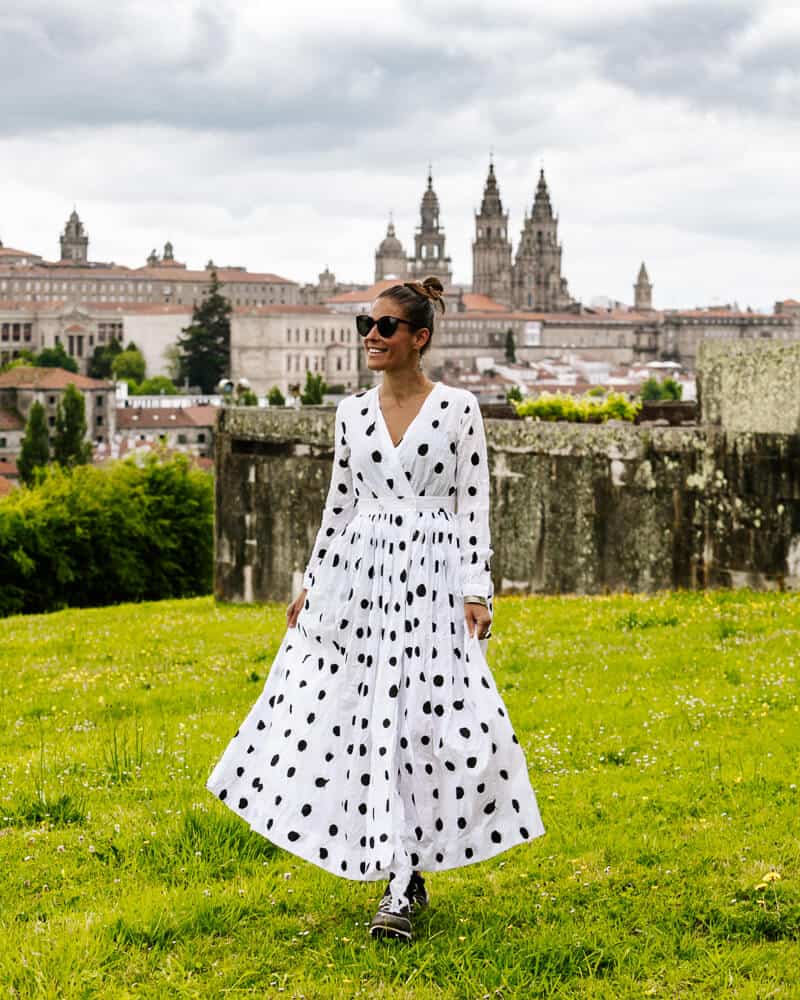
The Camino de Santiago, also known as the Way of Saint James, is a network of pilgrimage routes that run through various European countries to the city of Santiago de Compostela in Galicia, Spain. The route ends at the Cathedral of Santiago de Compostela, where the tomb of the Apostle Saint James is located. In the Middle Ages, this pilgrimage route was the most important in Europe, and it still attracts people from all over the world. Because of spiritual beliefs, personal development, growth, or simply to break free from the daily grind, follow in the footsteps of a pilgrim and enjoy a nice hike.
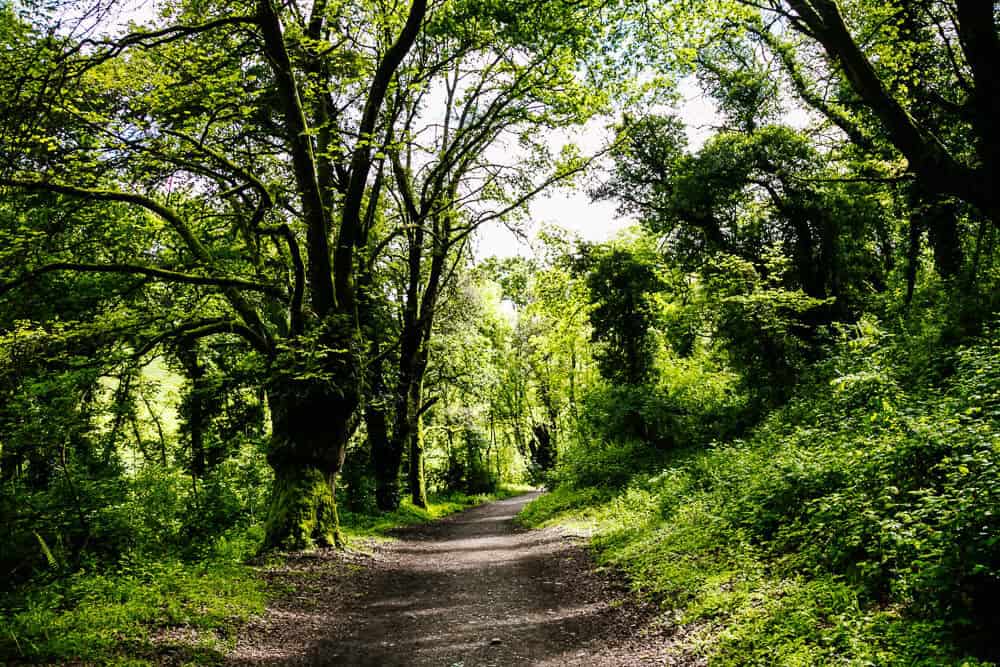
The walk is on many people’s bucket lists, as it was on mine for a long time. When I got the chance to take this Camino de Santiago walk, I didn’t hesitate for a second.
Since the Camino de Santiago consists of more than nine different routes and crosses various countries, finding the route that best suits you can be a challenge. That’s where the expert organization and planner Follow the Camino comes in. Of course, you need to think about how much time you have and what you want to see along the way. But Follow the Camino helps you plan a custom route, books accommodations, meals, a luggage service, and gives you many tips and tricks for preparation. I decided to go for the Camino Frances, one of the most popular routes, and walk the last 100 km to Santiago de Compostela. In this article, I’ll tell you everything you need to know about walking this special Camino de Santiago route.

Curious about the different Camino de Santiago routes? Be sure to check out the Follow the Camino website. Here, you’ll quickly get an idea of the numerous possibilities.
The entire Camino Frances is a whopping 800 kilometers and 31 stages long. From St Jean Pied de Port in France, you walk through the Pyrenees, across northern Spain, passing cities like Pamplona, Burgos, and Leon, to Santiago de Compostela. The Camino Frances has also inspired many writers and filmmakers, such as Paulo Coelho with his book “The Pilgrimage” and the Hollywood film “The Way” with Martin Sheen.
The last 100 km to Santiago de Compostela of the Camino Frances is a route you can complete in five days, walking an average of 24 kilometers per day. The 100 km is the minimum distance you must walk to qualify for an official Pilgrim Certificate. Upon arrival, you receive a pilgrim passport in which you collect stamps throughout your Camino de Santiago route, which is needed at the end to obtain the certificate. And I can personally say that the proof of a successfully completed pilgrimage gives you more satisfaction than you initially thought – I’ll explain later.

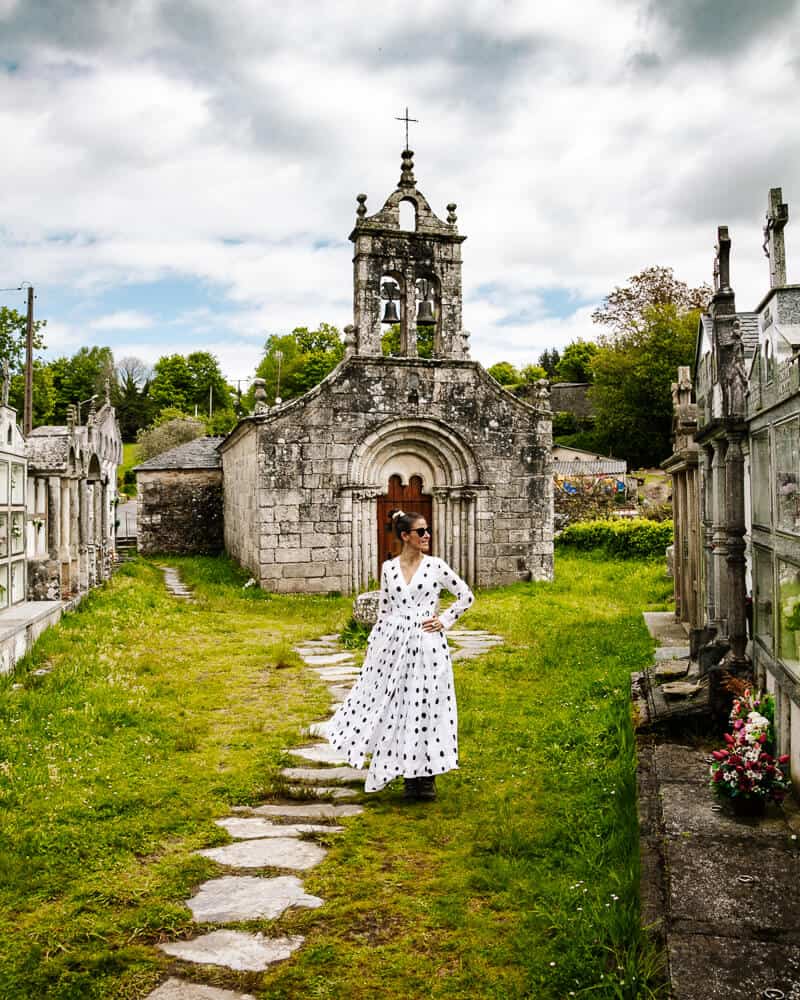
Want to walk this Camino de Santiago route? Then you will start in Sarria and sleep in various towns and villages along the way. Until you reach Santiago de Compostela. If you arrange this through Follow the Camino, you’ll also stay in lovely boutique hotels, with the option of a three-course menu included. Moreover you have your luggage transported daily. Curious? Read more about my experiences during the Camino Frances.
How does everything work? Do you need to train? What should you bring? After booking with Follow the Camino, you gain access to your client area, and preparations begin. You’ll receive messages and information about your Camino de Santiago route – weeks in advance, so you go well-prepared. There is also a pre-departure meeting where you can ask all your questions with one of their experts. And then, the time has come.
Want to know more about the Camino de Santiago walk? Read more in my article Camino de Santiago walk – Everything You Need to Know.

If there is one phrase you should learn before walking the Camino de Santiago, it’s “Buen Camino.” It means “good way” or “good journey” and it is something every walker uses as a greeting along the way. Of course, you are a pilgrim now and all share the same path and goal: Santiago de Compostela.
Since we are walking the last 100 km of the Camino Frances from Sarria to Santiago de Compostela, we fly to Santiago and take a transfer to Sarria, which takes about an hour and a half. It is recommended to take an early flight so you can explore Sarria and prepare before your Camino de Santiago adventure officially starts.
Sarria is the largest town along the Camino Frances and the start of the last 100 km to Santiago de Compostela.
The first day is always exciting, and I immediately feel the anticipation. How tough will it be? Can I keep up? Will we find the way? We leave our large luggage at the front desk of our accommodation for the night, get our first stamp in our pilgrim passport, and set off as official pilgrims with our daypack, looking for the first Camino de Santiago route signs. Since we arrived late the night before, we leave around 10 am. This turns out to be a good decision, as there are not many people on the trail. In Sarria, we also realize that finding the trail is not going to be a problem. There are signs with yellow arrows everywhere and we also see the scallop shells, an old and still important symbol of the Camino to Santiago. Both serve as essential guides for the Camino Frances.

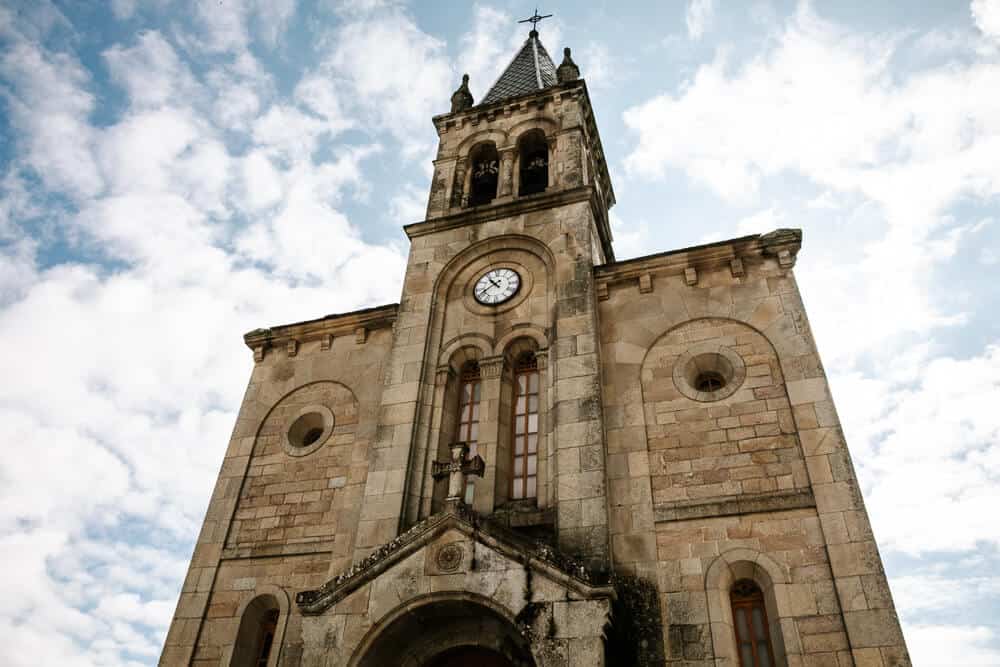
Once we leave the town of Sarria, we find ourselves in an environment where pine forests, meadows, and small villages with old stone houses alternate. We get our first taste of the Galician landscape, which is green and fertile. Birds serenade us along the way, and with the sun shining, time passes faster than we think. Before we know it, we’re halfway, and it’s time for lunch. We’re surprised by the number of bars and restaurants along the way. And it is tempting to not stop at each one for a drink.


After a simple Spanish lunch of bocadillos, omelets, and salad, we continue our Camino de Santiago route. It is only two more hours to our overnight place: Portomarin. Even though today’s route is nice and relatively easy, without any major climbs or descents, we’re happy to see Portomarin in the distance. It means we almost made it to our first destination.
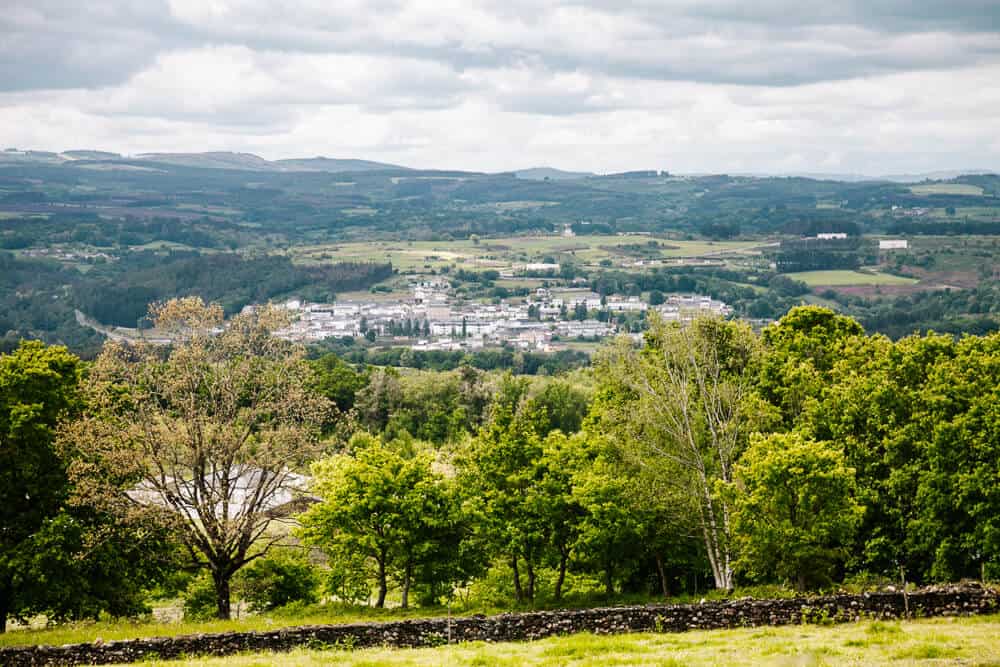

In Portomarin, we head straight to our centrally located hotel, VistaAlegre, where our luggage is already waiting for us. In the cozy main street, we celebrate the end of our first day with a good glass of wine before sitting down at our reserved table in a typical Spanish restaurant with a menu of tortilla, soup, hake, and Galician wine.
Portomarín is a medieval town located on the Mino River. Portomarin is known for its 400-meter-long Romanesque staircase, leading to the city.
Every evening, we read through the Camino de Santiago route for the next day: Today is 24 kilometers. After leaving our luggage and having a good breakfast, we set off in high spirits. Leaving Portomarin, we face our first climb, which is considered challenging due to the distance. We find it manageable.
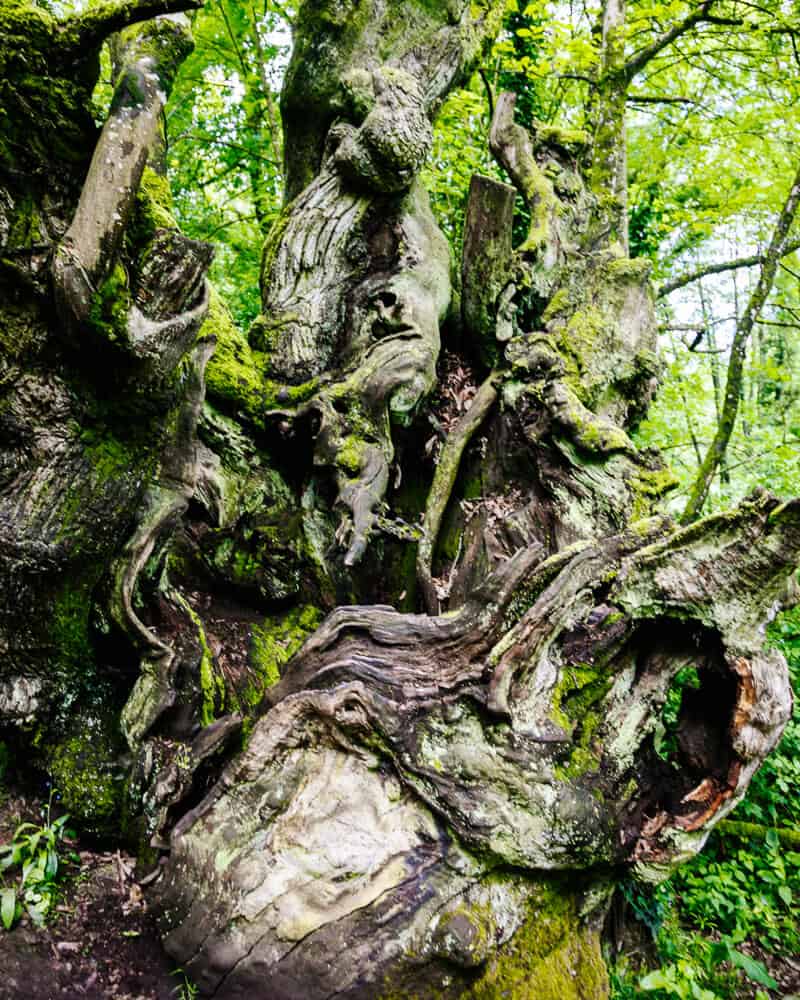
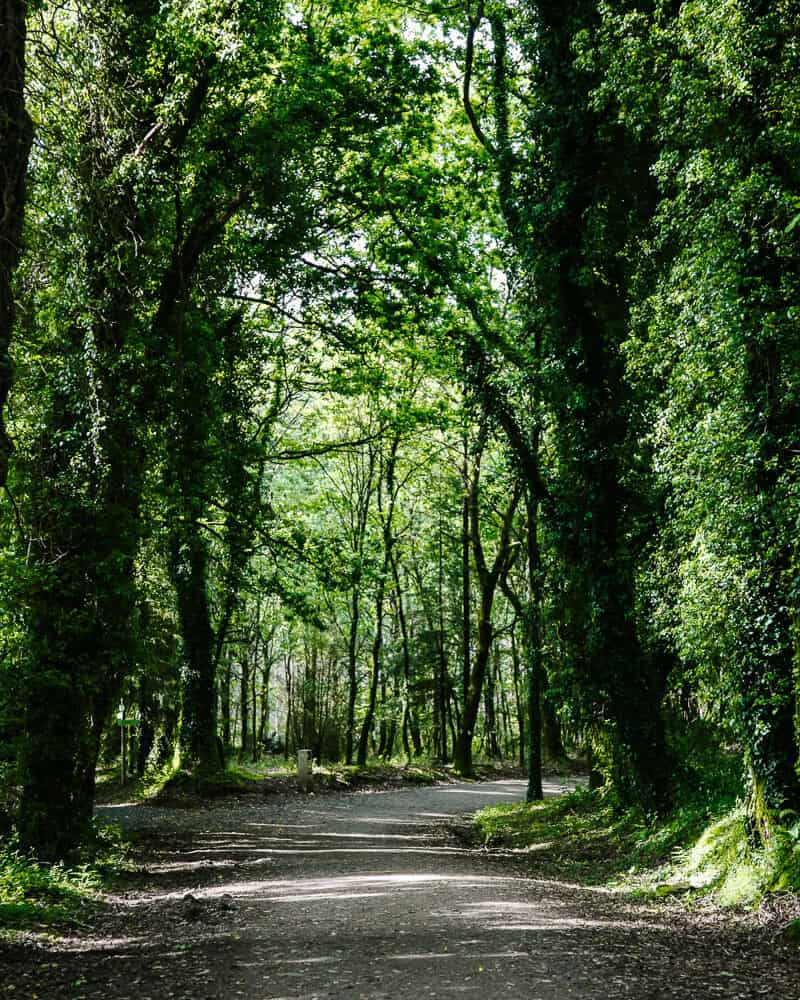
We encounter trees that are thousands of years old: Ancient oaks, overgrown with greenery in mysterious shapes. The longer you walk through a green environment, the more you notice these things. From time to time, we pass a village and meadows with farmers hard at work. Although there are special pilgrim paths everywhere, we walk large parts along the road. It’s a bit disappointing, but understandable given the developments since the first pilgrims walked here. We decide to accept and embrace the environment. Out of curiosity, we enter a few abandoned factories completely taken over by greenery.

One of the highlights today is the village of Castromaior, where we not only have a drink but also visit the 2000 year old Celtic ruins of Castro de Castromaior. Recent excavations have found evidence of habitation from the 4th century BC, until the arrival of the Romans. You have to take a detour to get there, but it’s worth it. It is a great place to take photos and enjoy the views of the Galician countryside


Upon reaching Palas de Rei, a transfer is waiting to take us to A Parada das Bestas. This three-hundred-year-old farmhouse, located in the green meadows of Galicia, has been transformed into a boutique hotel that is surrounded by ancient trees and countless birds. After drinking a few glasses of wine, while enjoying the evening sun, we are invited in the cozy dining room, for a fantastic three-course menu, where every dish is a new surprise.
Palas de Rei was, according to the Codex Calixtinus, a mandatory stop during the final stage to the tomb of the apostle James – a journey of 68 kilometers. The village has a number of beautiful buildings, which made it one of the favorite places to stay for the Galician nobility.
Today is the longest day of the last 100 km from Sarria to Santiago de Compostela: 29 kilometers are waiting for us to walk. We are brought back by car to Palas de Rei where we continue our trail. And today, we really start to feel our legs.
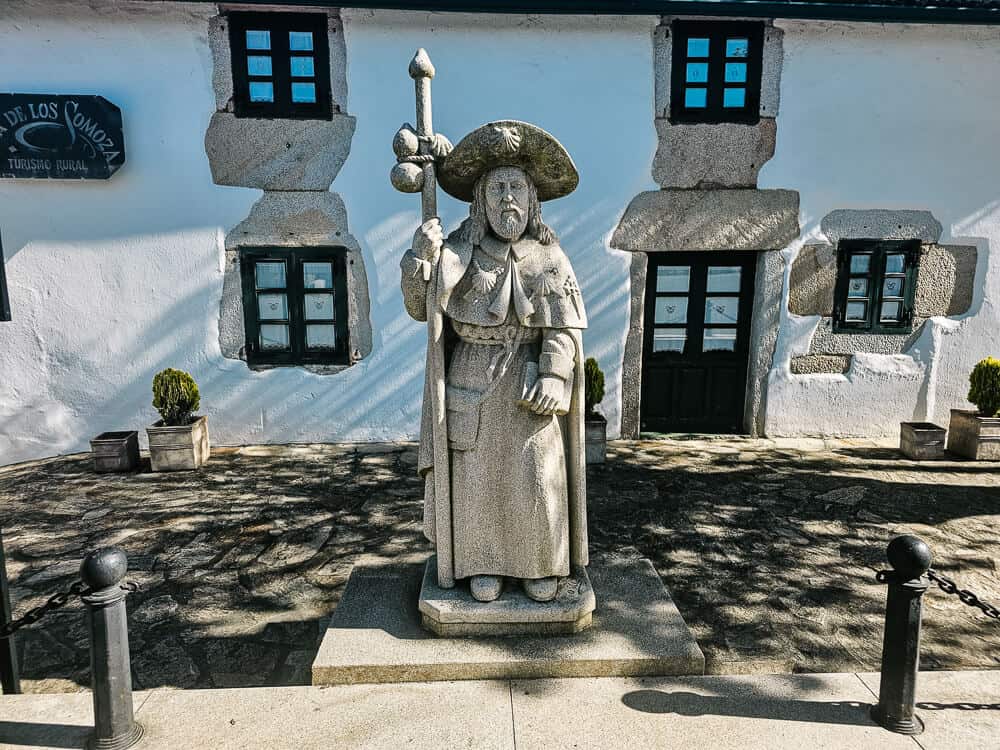
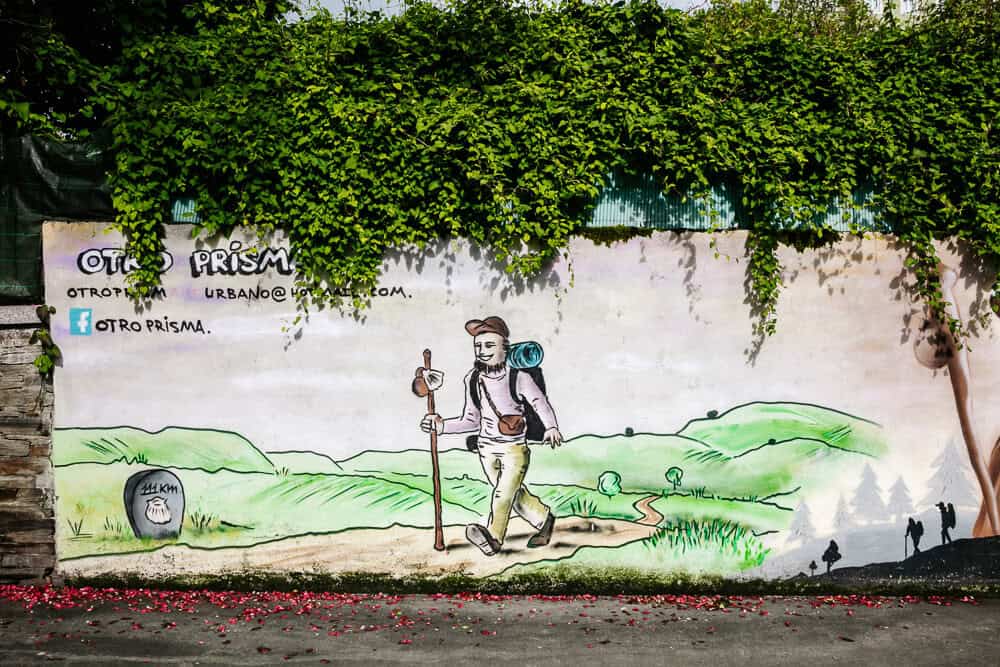
We can tell that everybody starts early on the Camino de Santiago, as it is busy. For me, a great possibility to look around and observe the type of people on this adventure. Soon, I realize there is no definition of a Camino de Santiago walker. I see solo travelers with large backpacks, couples, groups of Latinos, Koreans and Spanish, obvious retirees, and even people with strollers. You find all types of people here. And where in some countries you can immediately tell if someone is a hiker, here anyone can be a walker on the Camino de Santiago route.
Since we find 29 kilometers quite challenging, we decide to take a few extra breaks for drinks and pictures. We’ve also become quite keen on collecting stamps. Along the Camino de Santiago route, in hotels, restaurants, shops, and churches, you can get your pilgrim passport stamped. Initially, we stuck to the minimum of two stamps needed for our certificate, but now we find it an enjoyable activity and stop especially at chapels and artists, as they often have the most beautiful ones.
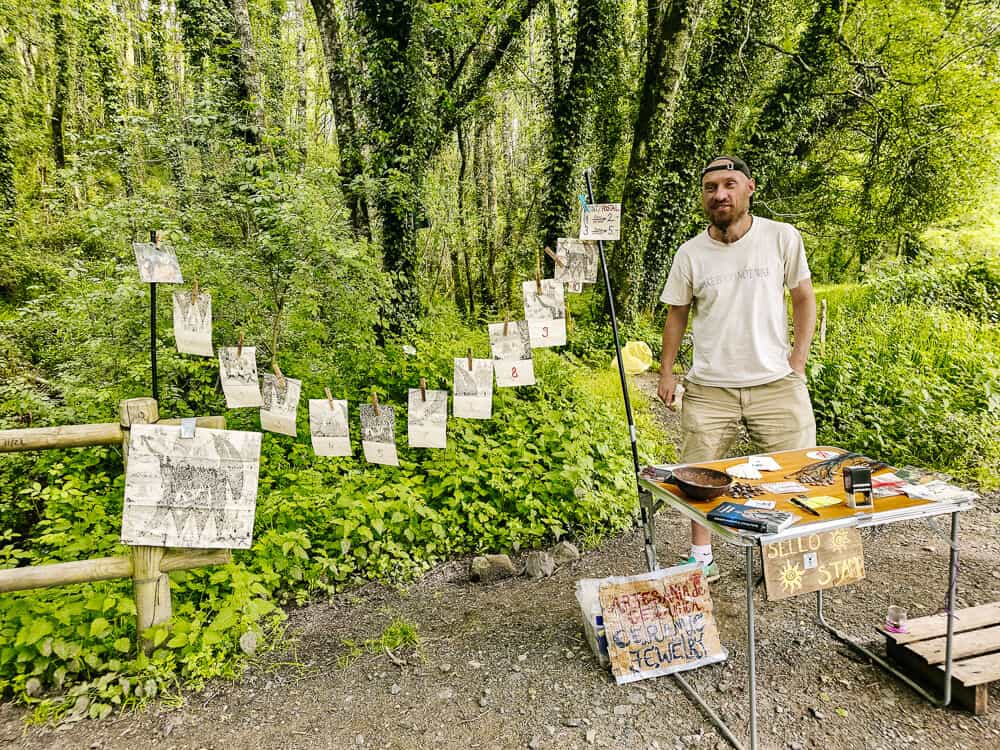
The route today is a mix of country roads and pilgrim paths through forests and meadows. With the sun high in the sky and the adrenaline still flowing from our adventure, the day goes by quickly. At least until the last kilometers. The last hour seems to drag on, and we check our step counter for the kilometers more often than usual. When we reach Arzua, it turns out our hotel is at the end of the village. The next morning we’re happy about this, but after walking 28 kilometers today, you can guess our thoughts.


1930 boutique hotel is one of the most beautiful little hotels you can imagine. This small-scale hotel, located in a large garden with a swimming pool, is nicely decorated. Everywhere you look, there are flamingos, greenery, mirrors, and stylish objects. The luggage is already in the room, and after a long hot shower, we end the day in style. On the top floor, a three-course dinner with well-filled glasses of wine awaits us.


Arzua is the place where the Camino del Norte and Camino Frances meet, to continue the road to Santiago de Compostela. Arzúa is also known for its cheese, considered one of the best in Spain, due to the local cow’s milk.
We start with a royal breakfast and could imagine staying here for more tea and snacks the entire morning. But a new day of the Camino de Santiago route is planned. It’s one of those days that make it so worthwhile. Since we left a bit later, we encounter few people along the way. We walk through pine forests, meadows with distant views, and pass small villages where time seems to have stood still. With a clear blue sky and a symphony of bird songs, we experience moments of pure happiness. The ancient pilgrim paths are also interesting to observe, with stone walls on either side, overgrown with all sorts of plants and grass.


Since we received a tip about a restaurant at the end of the route, with apparently the best tortilla in Galicia, we decide to have two lunches today. With 18 kilometers, it is the shortest day of the last 100 km to Santiago de Compostela, so we feel we can indulge. A week ago, we would have found this a challenging distance, but now it already feels normal.
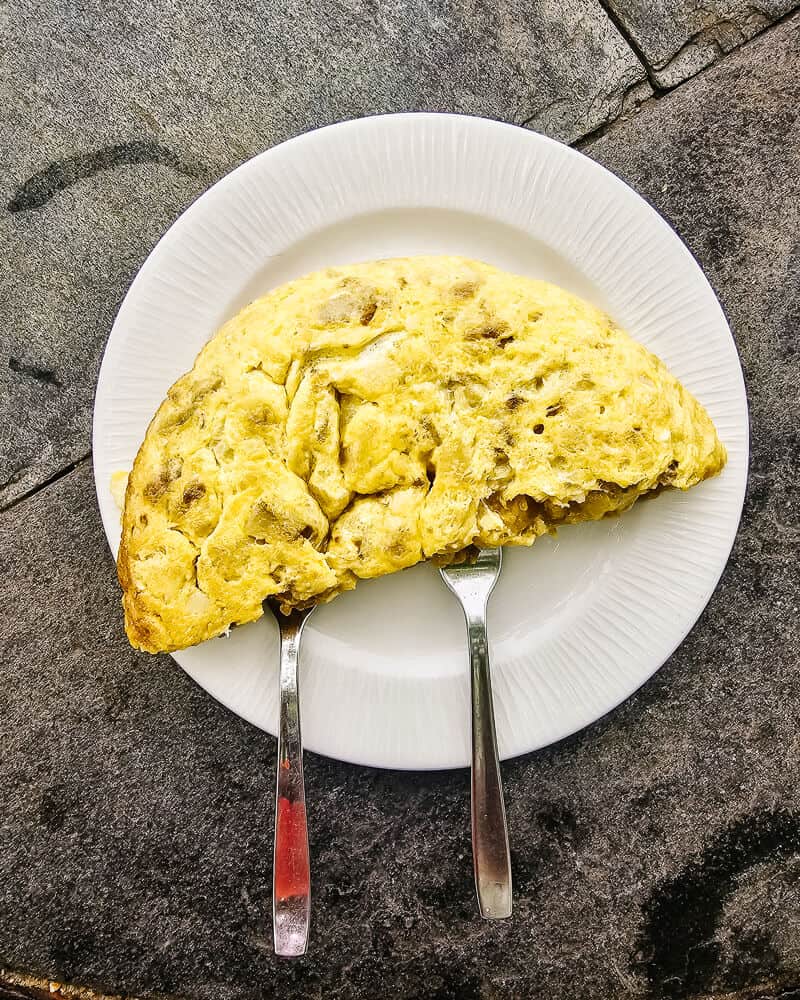

After our second lunch at O Ceadoiro, indeed with a delicious tortilla, we even decide to walk a few extra kilometers, instead of taking a transfer to our hotel. Our hotel for the night is not located in the small village of A Rua but in a natural environment beyond. That doesn’t mean we’re not tired; the fatigue is real. But it’s becoming a habit, and when you feel good and the weather cooperates, you get into a flow that takes you further than you might have thought.
Upon arrival at our hotel, we can’t believe our eyes. Vila Sen Vento is located in a wide green area with luxurious freestanding cabins accessible by stairs. The cabins have a living room with a fireplace, kitchen, bedroom with a view, and a terrace with a private jacuzzi. What more could you want after a day of walking? Maybe dinner? And that’s taken care of too. After some relaxation, a van takes us to a local restaurant for a three-course meal with matching Galician wine.


After a lovely breakfast in the cabin, we’re transferred back to where we ended yesterday. Today, of course, is all about the final goal: Santiago de Compostela, a little under 20 kilometers away. And you can feel it along the way. In every village, there’s a festive atmosphere, and the walkers you meet have an extra spring in their step. Some people have been walking for weeks and have surpassed their expectations for themselves. Even though the distance today is still 20 kilometers, it seems to pass quickly. The kilometer markers seem to drop with every step.


The first part of the route Camino de Santiago runs through beautiful dense forests and meadows. Then you reach the area around the airport. Not the most beautiful part, but it means that you’re approaching your endpoint. We arrived here only a week ago. A significant climb compared to the past days of the Camino Frances leads to Monte de Gozo (368m), where pilgrims in the Middle Ages first saw Santiago. The view must have been so impressive after weeks or even months of walking. Today, you can still see the cathedral towers in the distance, but the surrounding new buildings make it less magical. It’s worth going slightly off-route to visit the large pilgrim statues overlooking Santiago.
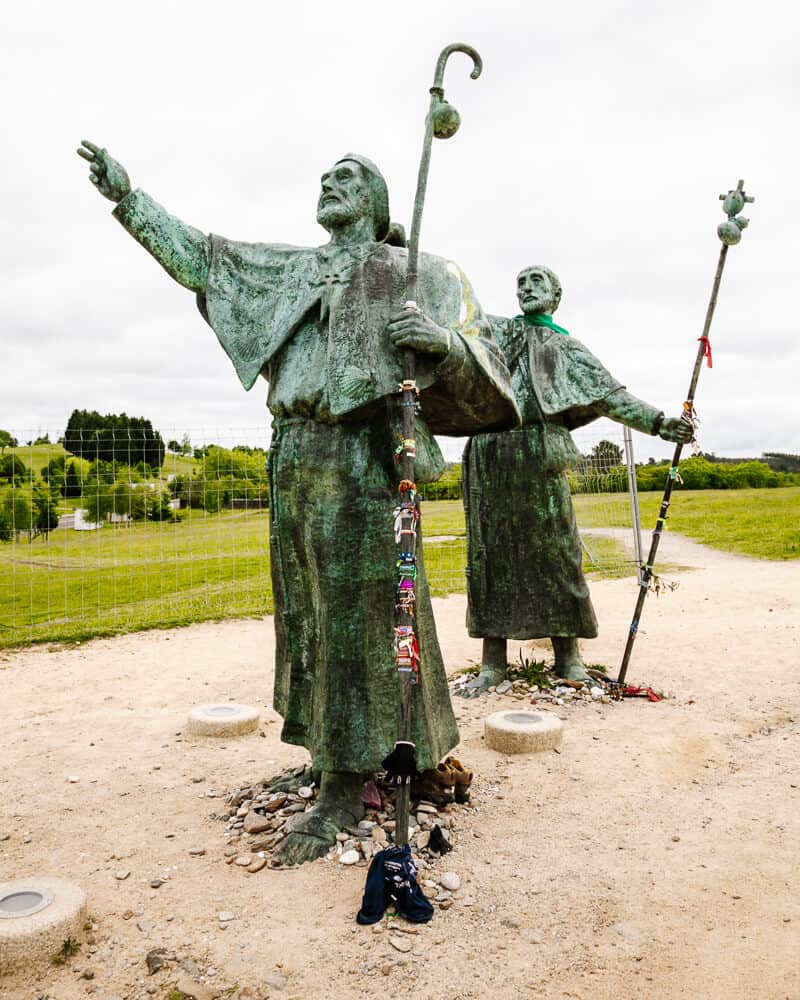

Then we descend towards Santiago. You feel that the end is near as pilgrims take different routes. Despite the strange sensation of arriving in a big city with your backpack while everyday life goes on, we decide to follow the path directly to the cathedral. On the central square in front of the cathedral, you’re amazed by the number of people who have arrived here, each in their own way: as a walker or cyclist after perhaps days, weeks or months on the Camino de Santiago route or just as a regular tourist. We settle down on a terrace and decide to celebrate our achievement.
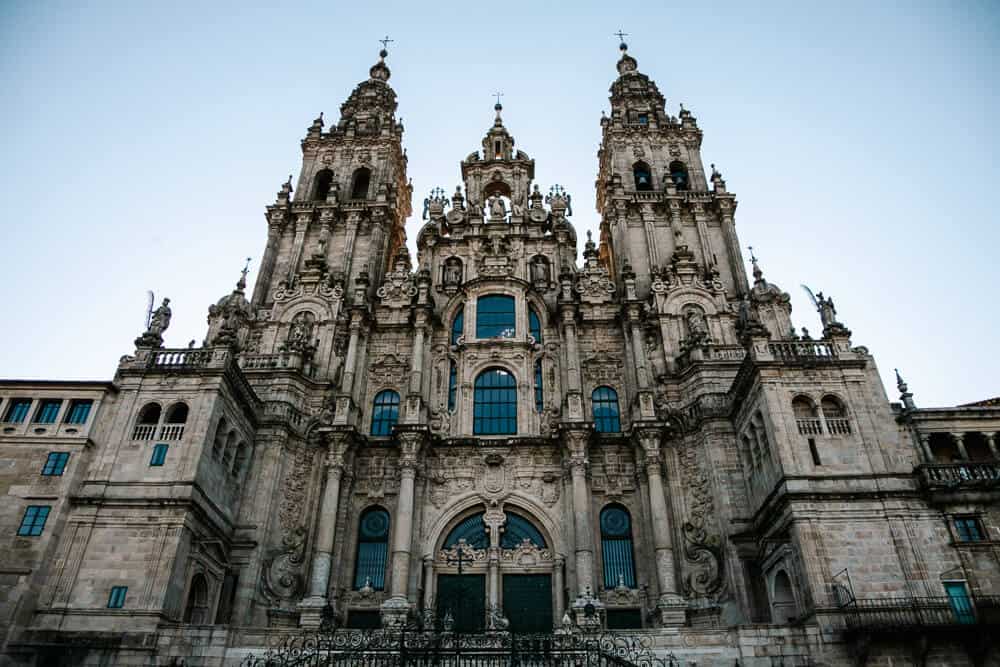

When you have completed the last 100 km to Santiago de Compostela, you can of course take the first plane home. But it is better to end your adventure with two nights in Santiago de Compostela, so you have time to relax and experience a little more of the special atmosphere. You can always choose to continue your walking adventure to Finisterre, meaning “end of the earth”. This is the only route that goes away from Santiago de Compostela.

If you opt to stay in the city, there are countless churches and sights. The cathedral, which is also on the UNESCO World Heritage List, is of course one of the highlights. It is also recommended to visit one of the viewpoints and observe the cathedral from a distance. And don’t forget to enjoy amazing tapas snacks with sangria and pulpo, local squid, in one of the many restaurants. Follow the Camino can arrange the accommodation, from boutique hostels to comfortable hotels, for your extended Santiago stay.
Have you, like me, always wanted to see the rugged coast of Galicia in Spain? Then it is recommended to book a day tour to Rias Baixas. During this tour you will not only enjoy the Galician landscape but you will also get to know the local gastronomy. O grove is known as the seafood paradise. During a boat trip on the Ria de Arousa you will be served unlimited mussels and local wines, while listening to explanations about the production of seafood. Afterwards you will visit an Albariño vineyard and make stops in Combarro and the island of A Toxa. The stop on the coast at Hermitage of the Lanzada has made me want to explore even more of this region.


Las Rías Baixas is a coastal region with lots of greenery and hills in the south of Galicia Spain. The region is known for its dry white wines from the Albariño grape. Rías Baixas is one of four classified wine regions in Galicia.
When reading about the Camino de Santiago, you’ll come across the pilgrim passport, credential del peregrino. This is a special booklet where you can collect stamps. Something that seems small at first becomes an important part of your journey. You can get stamps in churches, restaurants and hotels along the path and many of them are beautiful and unique. You need at least two stamps per day to collect your official Compostela Pilgrims Certificate.

In Santiago, you can pick up your Santiago certificate with your pilgrim passport at the Oficina de Acogida al Peregrino, the Pilgrim Office near the cathedral. Be prepared for long lines, but after walking the Santiago de Compostela route, you won’t want to miss out on this souvenir.
Follow the Camino provides you with a detailed route description, walking notes and maps. But you’ll quickly realize that you don’t have to make much effort to find the way. During your walk, you’ll find yellow arrows combined with a scallop shell, an old and still important symbol of the Camino everywhere. Both symbols lead you all the way to Santiago de Compostela. It’s still advisable to familiarize yourself with the route beforehand so you know what to expect and can make a plan.


It is important to know that during the last 100 km from Sarria to Santiago de Compostela on the Camino Frances, you walk an average of 24 kilometers per day. This means you must enjoy walking and have a good basic level of fitness. Since I am used to hiking, I personally don’t need much training to complete a trek like this. The last 100 km to Santiago de Compostela is accessible and not difficult in terms of elevation. Moreover there are plenty of places to rest along the Santiago de Compostela route.
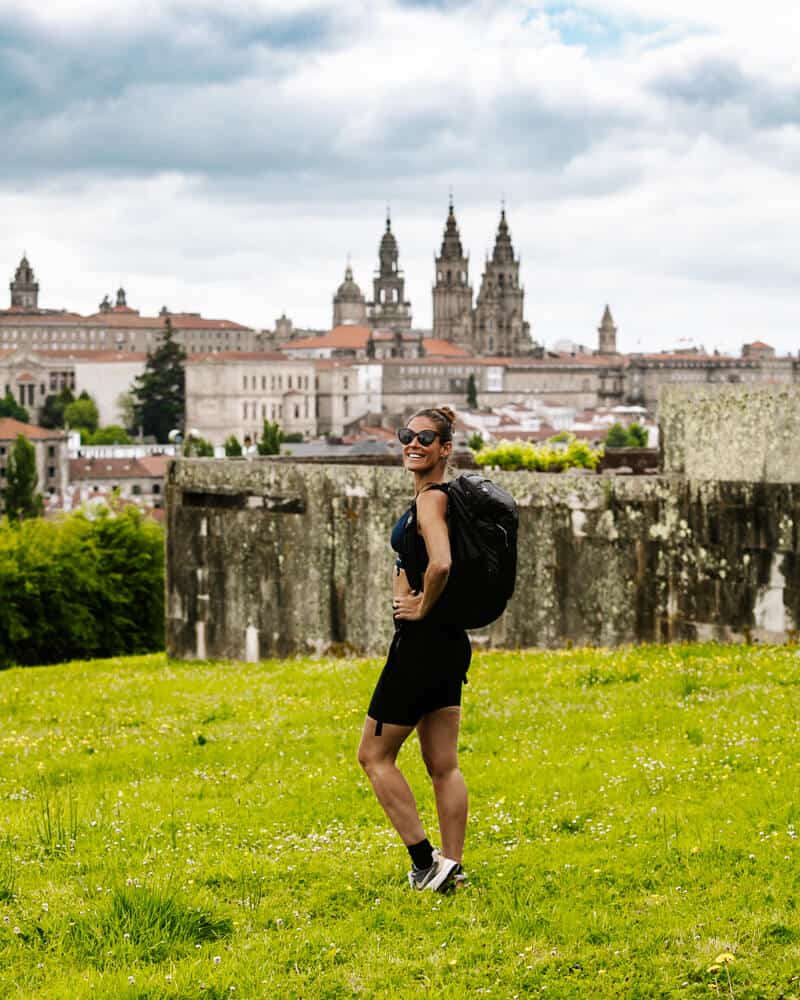
However, there will be moments when you have to push through, especially since you’ll feel the fatigue in your legs after a few days. To get the most out of your walk, you want to be both physically and mentally prepared. If you plan to walk the entire Camino Frances, you’ll be on the road for about 30 days. It is therefore essential to train in advance.
There are several ways to plan your Camino de Santiago route. One of the best options is to a Santiago de Compostela planner like Follow the Camino. Based on your preferences, they help you plan a custom route, book accommodation and meals, transfer your luggage, and give you many tips and tricks for preparation. After booking, you enter your client area and are guided through all preparations from A to Z.
Want to know more about the Camino de Santiago walk? Read more in my article Camino de Santiago walk – Everything You Need to Know.
Follow the Camino helps you organize your custom Camino, so you only have to focus on walking to Santiago de Compostela. A package based on your preferences includes the following:
Want to know more about follow the Camino? Check out the website.
Want to know more about the Camino de Santiago? Read more in my article Camino de Santiago walk – Everything You Need to Know.
This article may contain affiliate links. If you purchase something using one of our links, we may receive a commission at no extra cost to you, which helps us keep this blog alive. Thank you for your support! Please see our disclosures for more information.